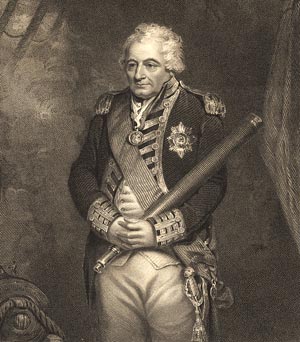
Archive sources
|
John Jervis, Baron Jervis of Meaford, Earl St. Vincent (1735-1823)John Jervis was the second of four children of Swynfen Jervis of Meaford in Stone, Staffordshire. Jervis was educated at Burton-upon-Trent grammar school and at the Reverend Samuel Swinden’s academy in Greenwich from 1742. He ran away to Woolwich to join the navy in 1748, but was discovered and returned home. On 4 January 1749 he entered the navy as an able seaman on the Gloucester, under Captain Lord Colvill, following an introduction to the Honourable George Townshead, commodore and commander-in-chief on the Jamaica station. Jervis served on the Gloucester until 25 June 1752 when he moved to the Severn as midshipman, then the Sphinx in June 1754 on board which he returned to England. After serving a month on board the Seaford and another on the Mary, he completed his six years of work and passed the examination to become a lieutenant on 22nd January 1755. Jervis served on a number of vessels during the Seven Years War (1756-1763). In July 1759, he was made acting commander of the Porcupine. With the frigate Halifax, the Porcupine led the ships in charge of transports past Quebec to take part in the capture of that fortress. During the American War of Independence (1775-1783), Jervis commanded the Foudroyant. In 1778, she became part of Admiral Augustus Keppel’s Channel Fleet and took part in the battle of Ushant on 27 July 1778. In April 1782, Jervis captured a French ship the Pegase off Ushant, for which he was made a Knight of the Bath. In peace-time, Jervis stood as Member of Parliament for Launceston in Cornwall and Chipping Wycombe in Buckinghamshire. However, in 1794 he left Parliament to take up active service again. In 1795 he took command of the Mediterranean Fleet against Napoleon. In February 1797, he defeated the Spanish Fleet off Cape St. Vincent, and in recognition of this victory he was created Earl St Vincent on 23 June 1797. He took command of the Channel Fleet in spring 1800, until he relinquished this on becoming first Lord of the Admiralty in February 1801. Then again, from 1806 until 1807 when he finally retired, he took command of the Channel Fleet, successfully blockading the French port of Brest. The RecordsRecords relating to John Jervis’s career and personal life can be found within the family papers of the Parker-Jervis family, which are held at the William Salt Library, Stafford (main collection reference number The images relating to John Jervis are reproduced by kind permission of the Trustees of the William Salt Library, Stafford. |
